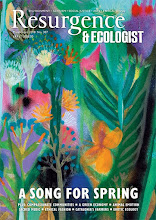I've attended many specialist festivals on the Dartington Hall estate over the last ten years, all of which have been stimulating, nourishing food for mind, heart and soul. But of all the festivals visited within those stunning grounds and buildings, Tagore 150 was the most rounded, holistic and nourishing I've experienced. A dynamic, inspirational programme of music, discussion, theatre, daily Culture Cafe's, dance, celebrated authors, philosophers, artists, scientists and activists bringing to the frontline the huge body of work of one astonishing human being.
Rabindranath Tagore was a man, an activist, an artist, a radical teacher, an environmental champion, a dancer and best loved of all a writer of many great literary works culminating in his award of the Nobel Prize for literature in 1913. This was a festival and celebration of life that he would have been proud of.
Before the festival I knew very little about Tagore's work and life. After the festival I feel I have stepped deep into the personal and professional world of one very fine individual and the celebration of an extraordinary career brought vividly to life through the words, ideas and art of over 100 different contributors throughout the week-long celebration.
What's important to me when faced with an individual's overwhelming achievements is not to be daunted and deflated in the face of such a visible, powerful body of work, but to be inspired by it, energised and galvanised to keep pushing ahead, keep moving forward; to keep the faith in the darkest hours of life. To be motivated by the belief that however small my contribution to this world is, what I do will ripple out into the future like a pebble on water. I've no idea where the fluid, rippling rings of my life's work will end up. If the pebble is dropped into the ocean, my life's work might perhaps one day become a mighty wave connecting to all living things. The wave of Tagore's life is still moving out, inspiring the world, one person at a time, to dare to offer their unique talents to society in the hope that they may also inspire reverence and respect for a life well lived.
Well done to all the volunteers, staff, artists and to Victoria who produced the festival from start to finish.
Rabindranath Tagore was a man, an activist, an artist, a radical teacher, an environmental champion, a dancer and best loved of all a writer of many great literary works culminating in his award of the Nobel Prize for literature in 1913. This was a festival and celebration of life that he would have been proud of.
Before the festival I knew very little about Tagore's work and life. After the festival I feel I have stepped deep into the personal and professional world of one very fine individual and the celebration of an extraordinary career brought vividly to life through the words, ideas and art of over 100 different contributors throughout the week-long celebration.
What's important to me when faced with an individual's overwhelming achievements is not to be daunted and deflated in the face of such a visible, powerful body of work, but to be inspired by it, energised and galvanised to keep pushing ahead, keep moving forward; to keep the faith in the darkest hours of life. To be motivated by the belief that however small my contribution to this world is, what I do will ripple out into the future like a pebble on water. I've no idea where the fluid, rippling rings of my life's work will end up. If the pebble is dropped into the ocean, my life's work might perhaps one day become a mighty wave connecting to all living things. The wave of Tagore's life is still moving out, inspiring the world, one person at a time, to dare to offer their unique talents to society in the hope that they may also inspire reverence and respect for a life well lived.
Well done to all the volunteers, staff, artists and to Victoria who produced the festival from start to finish.
Caspar Walsh is the film editor for Resurgence. He is an author, journalist and wilderness teacher. His new novel Blood Road is available in paperback.












